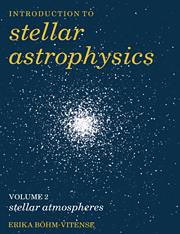Book contents
- Frontmatter
- Contents
- Preface
- 1 Stellar magnitudes and stellar colors
- 2 Stellar spectra
- 3 Temperature estimates for stars
- 4 Basics about radiative transfer
- 5 Radiative transfer in stellar atmospheres
- 6 The depth dependence of the source function
- 7 The continuous absorption coefficient
- 8 The influence of the non-greyness of the absorption coefficient
- 9 The pressure stratification
- 10 Theory of line formation
- 11 The hydrogen lines
- 12 Spectrum analysis
- 13 Basics about non-local thermodynamic equilibrium
- 14 The hydrogen convection zone
- 15 Stellar chromospheres, transition layers, and coronae
- 16 Stellar winds
- Problems
- Appendix LTE model stellar atmospheres
- References
- Index
11 - The hydrogen lines
Published online by Cambridge University Press: 08 February 2010
- Frontmatter
- Contents
- Preface
- 1 Stellar magnitudes and stellar colors
- 2 Stellar spectra
- 3 Temperature estimates for stars
- 4 Basics about radiative transfer
- 5 Radiative transfer in stellar atmospheres
- 6 The depth dependence of the source function
- 7 The continuous absorption coefficient
- 8 The influence of the non-greyness of the absorption coefficient
- 9 The pressure stratification
- 10 Theory of line formation
- 11 The hydrogen lines
- 12 Spectrum analysis
- 13 Basics about non-local thermodynamic equilibrium
- 14 The hydrogen convection zone
- 15 Stellar chromospheres, transition layers, and coronae
- 16 Stellar winds
- Problems
- Appendix LTE model stellar atmospheres
- References
- Index
Summary
The hydrogen lines deserve special consideration, not only because they are the strongest lines, but also because they are a very important tool in analyzing stellar spectra. The reason is that they are broadened by the so-called ‘molecular’ Stark effect, that is by the electric fields due to the passing ions. When a radiating atom or ion finds itself in an electric field, the energy levels are shifted to slightly different values of the excitation energy n or χexc The emitted lines therefore occur at slightly different wavelengths. Even more important is that for the hydrogen atom the different orbitals contributing to the energy level with a main quantum number n, are normally degenerate, i.e., when there is no external force field they all have the same excitation energy (this is, of course, indicated by the statistical weight for each level). In the presence of an external force field this degeneracy is removed, so that in an external field the different orbitals contributing to a given level with main quantum number n now occur at slightly different values for the excitation energy. This in turn means that, instead of one line being emitted in the force free case, there are now several lines emitted or absorbed at slightly different wavelengths. Fig. 11.1 shows the different components which are observed for the different Balmer lines.
This shifting of the energy levels in the electric field of the neighboring ions has mainly two effects. First, it shortens the lifetime of the undisturbed level which, according to equation (10.15), results in a broadening of the undisturbed energy level.
- Type
- Chapter
- Information
- Introduction to Stellar Astrophysics , pp. 136 - 139Publisher: Cambridge University PressPrint publication year: 1989



